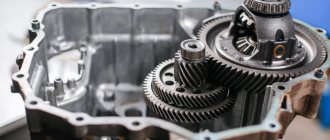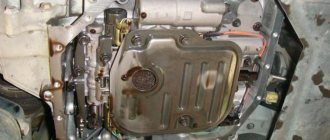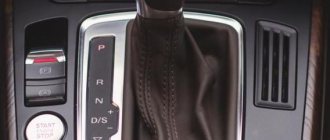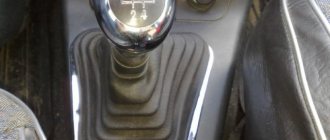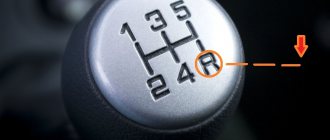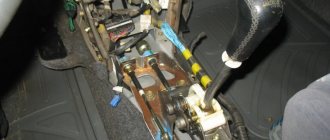On a car with an automatic transmission, vibration may occur in drive (D) with the brake pedal depressed. The reason is a faulty torque converter. Vibration is felt due to wear of parts due to oil starvation. Keep the lubricant level under control. Check the oil filter for contamination. If the condition of the consumable deteriorates, it stops passing a sufficient amount of lubricant. In some cases, wheel imbalance leads to breakdown of chassis components, which is also accompanied by jerking of the automatic transmission.
Automatic car jerks when stopping
Sometimes the car begins to experience shocks while braking. This is inconvenient when you are standing at a traffic light or parking lot. It is necessary to check the oil in the automatic transmission. Often the reason is:
- As the lubricant level increases, the pump is not able to pump enough lubricant, which does not reach the contacting parts in full.
- Low oil level leads to the same result.
- Dirty oil.
- Clogged filter.
Also inspect the cushions for wear.
Reasons related to the box
Vibration can cause some automatic transmission problems:
- Deformation of the input shaft of the box.
Sample of input shaft:
A change in the geometry of the shaft, which has occurred for some reason, can provoke vibration and beating felt by the driver. The box will vibrate during acceleration, regardless of the currently active gear.
- Insufficient oil level.
A lack of transmission fluid causes oil starvation of the elements; automatic transmissions are especially sensitive to the amount of oil. If it is not enough, the transmission components wear out at an accelerated pace; over time, the automatic transmission begins to vibrate, “push”, grind, until it eventually fails.
- Poor quality oil.
The wrong type of fluid poured into the box, oil wear and contamination with foreign particles can also cause the box to “kick” and vibrate. In addition, similar symptoms sometimes appear when driving in cold weather on an unheated gearbox, when the oil is viscous and does not provide proper performance characteristics.
- Worn out box cushions.
When you engage a gear, the automatic transmission vibrates and the speed drops
Often the reasons for an automatic machine being outside the box:
- Poor quality fuel. The injectors become clogged, and vibration from the engine when the gear is engaged is transmitted to the gearbox. At the same time, this leads to a decrease in engine speed.
- Ignition coil malfunction. When the gear is engaged, the engine operation becomes uneven, which is reflected in the gearbox in the form of vibration.
Vibration when accelerating
Vibration during acceleration may occur due to an unadapted automatic transmission. After repair or fluid replacement, each machine must undergo computer adjustment of gear ratios. Or the driver himself can do this. Methods for adapting an automatic transmission to the driving style of a particular driver were described in an article dedicated to adaptation.
If the vibration does not go away and appears when changing gears, the torque converter may be faulty. Computer diagnostics cannot check the “donut”. Therefore, you will have to completely disassemble the box and remove the torque converter. After disassembling and replacing the gas turbine engine, be sure to remember to balance the torque converter.
Write in the comments how you dealt with machine vibration?
Automatic transmission malfunction
If you have diagnosed the box and found a fault in the automatic transmission, then it needs repair. A malfunction in the torque converter during acceleration will give poor dynamics, and old oil will affect the appearance of jerks and jerks when switching.
Read
The design and principle of operation of the automatic transmission torque converter
If the gears are thrown down rarely, the acceleration dynamics are positive, the car does not push, but vibration is present, the problem may lie outside the automatic transmission. You will need to check the engine - the heart of the car.
Engine malfunction
A clogged engine fuel filter is a common cause of vibration in a car. Another reason could be bad fuel. Low-quality gasoline quickly clogs the injectors. The engine starts to slow down.
In the case of low-quality gasoline, the vibration will disappear during acceleration. But, if the ignition coils fail, the engine will begin to sneeze during acceleration. You will feel a drop in engine speed. The vibration from the engine will be transmitted to the entire car body.
If the lambda probe fails, the vibration will also spread throughout the body, as with a clogged throttle valve. It will be necessary to clean the damper and replace the lambda probe.
CV joints in the front axles
CV joints in the front axles are subject to premature wear. Especially if the car is not intended for driving on dirt roads, and the driver actively uses it under difficult operating conditions.
The constant velocity joints of the drives are worn out and it is difficult to notice with the eye. It is determined by the vibration that spreads throughout the body during acceleration.
The driver can also determine the problem with the CV joints by driving the car in one direction or the other on a straight road.
Write in the comments if you have experienced problems with worn CV joints? How was the fault determined?
Wheel bearing
A wheel bearing malfunction is determined by a crunching sound when driving and vibration through the body and into the steering wheel. When accelerating, the driver will feel as if something is slowing down his car.
Read
Which gearbox is more reliable and better: robot, CVT or automatic?
At the first appearance of such symptoms, I advise you to immediately go to a service station. You can create an emergency situation on the roads, since the car, if you do not pay attention to the problem, will increasingly and more often be pulled towards the wheel on which the wheel bearing has failed.
Warped disc or damaged tire
Improper balancing of the front wheels, especially, can create vibration. If the disc is deformed or the tire is damaged, the driver will feel not only vibration, but also deterioration in vehicle control.
It is better to immediately dismantle crooked rims and torn tires and replace them with new ones. Then you will create safe travel conditions for yourself and other road users.
When cold: disappears when warmed up
Automatic transmission vibration can occur on unheated units. The reason is the oil. Until the lubricant warms up, it has increased viscosity. As a result, the box parts work in slow motion. This is reflected in solenoids, which are electrical valves that open or close the passage of hydraulic fluid through the channels.
If their operation occurs in slow mode, then the fluid does not reach the clutch pack in a timely manner. As a result, at this moment the car jerks. This is most often observed on a box that has already worked for a long time. New solenoids usually solve this problem. When they have slight wear, opening occurs with a delay. After warming up the vibration disappears.
Causes of automatic transmission vibration
An automatic transmission is a complex device consisting of several interconnected components. It contains bearings, valves, gears and other elements that are in motion and capable of producing vibration if there is a problem. Improper installation of an automatic transmission can cause similar symptoms.
Schematic structure of a typical automatic transmission:
Box vibration manifests itself as a beating transmitted to the automatic transmission selector and body, felt by the driver. The beat can be of varying intensity and appear in different situations:
- idling;
- when accelerating a car;
- vibration when engaging reverse gear of the automatic transmission;
- when changing gears;
- when stopping or starting to move for a short time, if you press the brake in position D or “reverse”.
Important: vibration of the box is not always associated with problems with the automatic transmission itself; sometimes this phenomenon is associated with a malfunction of the chassis, engine, ignition, low-quality fuel, wheel imbalance, etc.
What else should you pay attention to?
Vibration when accelerating can be felt due to unreliable mounting of the engine and exhaust system parts. It is better to perform this check with the engine running and then turned off. There are also cases when shaking is caused by a damaged radiator fan.
Next, check the attachment. Often the problem can be solved by replacing the drive belts or balancing the pulley. It would be a good idea to check the clutch basket and flywheel. You can do this as follows. Depress the clutch and place the selector in first gear. Next, start the engine and wait a couple of seconds. Then the lever is moved to the neutral position and the foot is removed from the pedal. Are there still vibrations? Look for the problem in the flywheel and clutch basket.
The need for balancing
Neither tires nor wheels are perfect in terms of geometry and composition. So, due to different masses in different parts of the wheel, those places where the weight is greater will pull the wheel axle towards themselves. At high speeds, the force will be transmitted to the rods, then to the steering wheel.
It is very important to perform balancing from time to time. Especially after changing tires or wheels. Using this procedure, you can equalize the masses of the wheels at each point. Driving a vehicle with unbalanced wheels can cause rapid wear on the chassis and suspension, a problem that is more difficult to correct.
Typical automatic transmission faults | Automatic transmission repair in Samara
The main malfunctions of automatic gearboxes are the same for all models and do not depend on the manufacturer. This is due to the fact that the number of automatic transmission developers around the world is limited, and manufacturers simply replicate proven technical solutions.
The difficulties in diagnosing faults in hydraulic transmissions are primarily due to the fact that each car manufacturer adapts them to their control units in their own way.
A common disease of all automatic transmissions can be considered their inability to cope with aggressive driving style and increased requirements for the ATF used. It is insufficient attention to the level and condition of the filled oil that very often becomes the cause of serious breakdowns.
Automatic transmission vibration
Most often, the valve body is the culprit for automatic transmission vibration. As a rule, it occurs after a late ATF replacement. This is due to the fact that dirty oil led to clogging of the valve body channels and the development of solenoids.
Pure ATF penetrates through broken solenoid channels that are inaccessible to contaminated oil and causes unstable operation of the box, accompanied by an increased level of vibration. If vibration occurs in certain gears, the corresponding valves should be checked.
To eliminate this, it is necessary to flush the valve body and replace solenoids with signs of wear. Usually, after this simple procedure, the vibration of the transmission stops.
Repairs are completed within a day. The cost of vibration elimination services starts from 3,500 rubles.
Knock of automatic transmission
Automatic transmission knocking can be caused by a variety of reasons, but it needs to be eliminated as soon as possible.
Its cause may be mechanical destruction of the cushion on which the box rests, but it is much more serious when it is caused by destruction of the bushing in the pump body, damage to the spline joints, play of any pair of gears or destruction of the bearing. In any case, it is advisable to take the car in for diagnostics and not drive until the cause of the knocking is determined.
If a knocking noise appears when switching to a certain mode, then it will not be difficult for a specialist to determine its nature; it is worse and more dangerous when something knocks constantly.
Troubleshooting takes no more than one day, and the price for repairs starts from 3,500 rubles.
Signs of a torque converter malfunction
The torque converter is the most heavily loaded automatic transmission unit, ensuring the transmission of torque from the engine to the input shaft of the box. The main signs of a gas turbine engine malfunction are loss of acceleration dynamics caused by a breakdown of the overrunning clutch or the appearance of a characteristic buzzing sound, indicating that the filter is clogged with friction dust.
The appearance of slight vibration at speeds up to 90 km/h may indicate that the torque converter lockup has failed.
Diagnosis of gas turbine engine malfunctions is carried out by our specialists very accurately. The first sign of problems with the torque converter can be considered the presence of friction dust in the oil.
Repairs can take up to two days, and their cost starts from 6,500 rubles.
remont-akpp-samara.ru
Checking the suspension and chassis
Vibration when accelerating can occur as a result of natural wear and tear on the struts or shock absorbers. The suspension stops working smoothly, which is one of the causes of the problem. This can be especially noticeable on rough roads or when driving at speed.
Another popular cause of shaking is the support bearing on the strut. This part can be found on top, above the shock absorber. It is also checked under the hood from the front. If you can find a worn bearing, you should replace it, and then the problem will be solved.
Ball joints in most cases wear out due to driving on poor quality roads. In our country, these parts need to be changed very often. If you find play in the supports, then perhaps by replacing it you will be able to regain your comfort.
Check and, if necessary, replace the tie rod ends. Over time, play appears in this mechanism due to wear. Thanks to this tip, the car's wheels can turn parallel. Worn tips cause shaking.
Unreliable wheel mounts
This problem is also easy to fix and diagnose. This is a simple but very dangerous reason. The fastenings can be loosened even on one wheel, and this is enough to cause shaking. If the problem is not resolved in time, emergency situations may occur. If the wheel falls off while driving, the repair will be quite expensive - you will have to replace the disc and hub, and the brake disc.
The symptoms in this case are very similar to vibrations due to tires or bent wheels. But there is a cyclical pattern here, although not at all speeds.
CV joints in the front axles
Although this is not such a popular reason, it is a rather vulnerable spot, which is why vibration when accelerating is a common occurrence. Experienced car enthusiasts recommend starting diagnostics with this mechanism. The procedure must necessarily include a tactile test. If there are scratches, replace the equal angle hinges. It is better to replace this part in pairs.
Wheel alignment
If the wheel is installed at the wrong angle, this is also one of the reasons for unpleasant beating. Adjusting these angles is an important process once body vibrations are detected. What can be done to fix it? Adjust wheel alignment on a special stand. It is also recommended to replace the tires if it is visible that they are not wearing properly.

